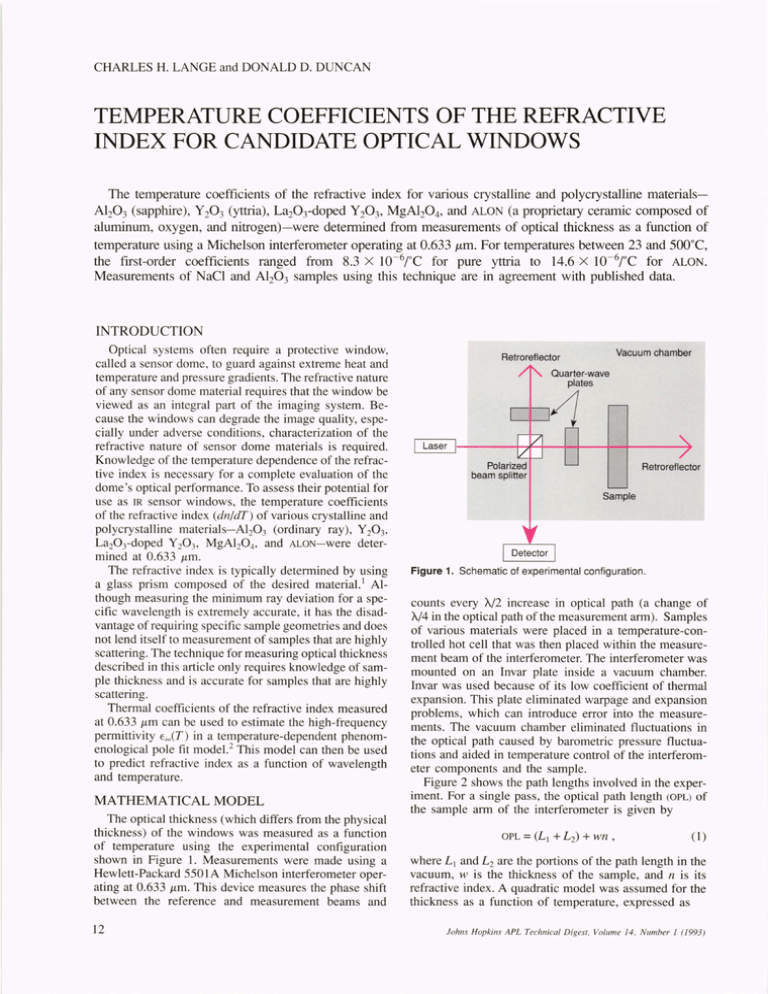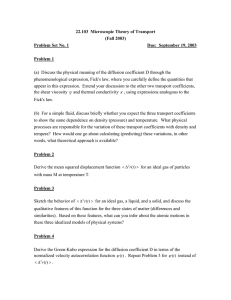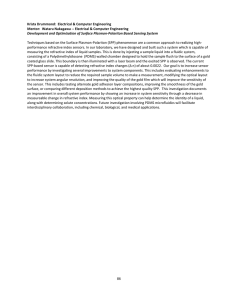TEMPERATURE COEFFICIENTS OF THE REFRACTIVE INDEX FOR CANDIDATE OPTICAL WINDOWS
advertisement

CHARLES H. LANGE and DONALD D. DUNCAN
TEMPERATURE COEFFICIENTS OF THE REFRACTIVE
INDEX FOR CANDIDATE OPTICAL WINDOWS
The temperature coefficients of the refractive index for various crystalline and polycrystalline materialsAl20 3 (sapphire), Y203 (yttria), La20 3-doped Y20 3, MgAI20 4, and ALON (a proprietary ceramic composed of
aluminum, oxygen, and nitrogen)-were determined from measurements of optical thickness as a function of
temperature using a Michelson interferometer operating at 0.633 11m. For temperatures between 23 and SOO°C,
the first-order coefficients ranged from 8.3 X 10- 6rC for pure yttria to 14.6 X 10- 6rC for ALON.
Measurements of NaCl and Al20 3 samples using this technique are in agreement with published data.
INTRODUCTION
Optical systems often require a protective window,
called a sensor dome, to guard against extreme heat and
temperature and pressure gradients. The refractive nature
of any sensor dome material requires that the window be
viewed as an integral part of the imaging system. Because the windows can degrade the image quality, especially under adver e conditions, characterization of the
refractive nature of ensor dome materials is required.
Knowledge of the temperature dependence of the refractive index is necessary for a complete evaluation of the
dome's optical performance. To assess their potential for
use as IR sensor windows, the temperature coefficients
of the refractive index (dn/dT) of various crystalline and
polycrystalline materials-Al20 3 (ordinary ray), Y203'
La20 rdoped Y20 3, MgAI 20 4 , and ALON-were determined at 0.633 p.m.
The refractive index is typically determined by using
a glass prism composed of the desired material. l Although measuring the minimum ray deviation for a specific wavelength is extremely accurate, it has the disadvantage of requiring specific sample geometries and does
not lend itself to measurement of samples that are highly
scattering. The technique for measuring optical thickness
described in this article only requires knowledge of sample thickness and is accurate for samples that are highly
scattering.
Thermal coefficients of the refractive index measured
at 0.633 p.m can be used to estimate the high-frequency
permittivity Eoo(T) in a temperature-dependent phenomenological pole fit model. 2 This model can then be used
to predict refractive index as a function of wavelength
and temperature.
MATHEMA TICAL MODEL
The optical thickness (which differs from the physical
thickness) of the windows was measured as a function
of temperature using the experimental configuration
shown in Figure 1. Measurements were made using a
Hewlett-Packard 5501A Michelson interferometer operating at 0.633 p.m. This device measures the phase shift
between the reference and measurement beams and
12
Vacuum chamber
Retroreflector
Quarter-wave
plates
,---I--,/j
Laser
Polarized
beam splitter
Retroreflector
Sample
Figure 1. Schematic of experimental configuration.
counts every A/2 increase in optical path (a change of
",/4 in the optical path of the measurement arm). Samples
of various materials were placed in a temperature-controlled hot cell that was then placed within the measurement beam of the interferometer. The interferometer was
mounted on an Invar plate inside a vacuum chamber.
Invar was used because of its low coefficient of thermal
expansion. This plate eliminated warpage and expansion
problems, which can introduce error into the measurements. The vacuum chamber eliminated fluctuations in
the optical path caused by barometric pressure fluctuations and aided in temperature control of the interferometer components and the sample.
Figure 2 shows the path lengths involved in the experiment. For a single pass, the optical path length (OPL) of
the sample arm of the interferometer is given by
(1)
where Ll and L2 are the portions of the path length in the
vacuum, w is the thickness of the sample, and n is its
refractive index. A quadratic model was assumed for the
thickness as a function of temperature, expressed as
f ohns Hopkins APL Technical Digest, Volume 14, Number 1 (/993)
(2)
(9b)
and for the refractive index,
where
(3)
(9c)
where (X I and (X2 are the linear and quadratic coefficients
of expansion expressed as a function of temperature; ao,
at> and a2 are the refractive index and it linear and
quadratic coefficients, respectively; and T is temperature.
The derivative of the OPL with respect to temperature is
obtained from Equation 1 by
RESULTS
dOPL
dL
dw
dn
- - =-+n-+wdT
dT
dT
dT'
(4)
where L is the sum of LI and L2 •
The partial derivatives with respect to the temperature
are from Equations 2 and 3 as follows:
(5)
(6)
From Figure 2, we note that
dL
dT
dw
dT
(7)
A second-order polynomial was fit by least-squares error
to the experimental optical path length data. The derivative of this fit with respect to temperature is given by
dOPL
dT
=b +2b T
1
The experiment was designed to determine the coefficients b l and b2 • The analysis relied upon various references for the refractive index n(To) and the coefficients
of thermal expansion (Xl and (X2 ' Equations 9a, 9b, and 9c
are the results of these calculations.
(8)
2'
where b l and b 2 are experimentally determined numbers.
From Equations 4 through 8 and equating like powers of
temperature, we obtain the following relationships between the desired coefficients and the experimentally
determined coefficients:
(9a)
Calculation of the refractive index of the thermal coefficients required knowledge of the sample's temperature. Since the thermocouple was located near the edge
of the sample and OPL was measured at the center of the
sample, the experiment required that the temperature be
uniform throughout the sample. The experiment took
roughly two days; a two-hour stabilization interval for
each temperature step ensured a uniform sample temperature. To provide continuous data, measurements were
taken every minute to determine whether the sample was
reaching a stable temperature. The temperature was raised
and lowered during the course of each experiment to
detect any variations in the sample temperature measurements with data taken during each phase. Figure 3 shows
a plot of the temperature history for sapphire during the
measurement period. The " hysteresis" appears because
the sample temperature lagged behind the temperature
recorded by the thermocouple. Figure 4 is the temperature-dependent OPL for N aCI; the data were taken after
the temperature had stabilized, that is, when the temperature was uniform across the sample.
A quadratic curve was fit to the data corresponding to
the stable temperature points. The first-order term reveals
the temperature variation of the optical path from which
dn/dT can be derived. A quadratic fit was used to obtain
a more accurate coefficient for the fust-order term. Typ-
60
E
-.::,
50
..c
40
~
30
0,
c
Beam splitter
Sample
Retroreflector
..c
10
a.
cou
>
Figure 2. Diagram of path length calculations.
Johns Hopkins APL Technical Digest , Volum e 14. Number 1 (1993)
20
'l i
0 10
0
-10
0
100
200
300
400
500
600
Temperature, T (0C)
Figure 3. Typical temperature history of a sapphire sample over a
54-hour measurement period at a wavelength of 0.633/Lm. Sample
thickness was 0.25 in, The convex upward portion of the curve is
the path taken on the heating cycle ; the concave upward portion
is the cooling cycle.
13
C. H. Lange and D. D. Duncan
10~----~----~----~----~----.-----.
E
Table 1. Dimensions and thermal coefficients of expansion for
various materials.
o
Linear
coefficient,
(XI (DC-I)
(X lQ-6)
Quadratic
coefficient,
2
(X? (DC - )
(X 10-9)
L~03-
0.070
0.250
0.250
0.234
44.0
39.7
4.1
6.18 ± 0.16
6.38 ± 0.36
6.72 ± 0.10
2.18 ± 0.19
1.53 ± 0.37
1.19±0.1O
doped Y20 3d
MgA1 20 4d
ALO d
0.197
0.250
6.21 ± 0.50
5.63 ± 0.07
3.03 ± 0.61
2.17 ± 0.07
--==
B, -10
c
~
~ -20
Material
Thickness,
Wo (in.)
c..
co
NaCla
NaClb
LiNb03 (C-cut)C
Al 20 3 (C-cut)d
Y20 3 (pure)d
.~ -30
o
-40
-50 L-----L-----~----~----~----~--~
o
100
200
300
400
500
600
Temperature, T (0C)
Figure 4. Optical path length (OPL) data and quadratic fit for NaCI
measured at a wavelength of 0.633 j-tm. (OPL = 0.837 - 0.0761 T
- 6.96 x 1O-sp.) The sample thickness was 0.204 in.
80
E
0,
c
Note: Dashes indicate that data are unavailable.
aData from Ref. 3.
bData from Ref. 4.
CData from Ref. 5.
dData from Ref. 6.
60
--==
..c
~
0.204
Table 2. Parameters of fit to optical path length data for various
materials.
40
..c
C\i
Linear
coefficient,
bl(f-lmfDq
Quadratic
coefficient,
b? (f-lm;oC2)
-(X lQ-6)
-0.076 136
0.022532
0.10437
0.090067
0.085504
0.086126
0.12090
-6.96
0.692
-10.9
-15.1
-17.1
-9.75
-7.80
c..
cou 20
a
0
Material
0
-20
0
100
200
300
400
500
600
Temperature, T (0C)
Figure 5. Optical path length (OPL) data and quadratic fit for ALON
measured at a wavelength of 0.633 j-tm. (OPL = - 2.26 + 0.121 T 7.80 x 1O-sp.) The sample thickness was 0.25 in .
ical data set and the resulting fits are shown in Figures 4
and 5.
The thermal coefficients of expansion (al and ( 2) for
the different materials are given in Table 1. Owing to the
similarities among the last five materials, their linear
coefficients all are within ±9% of the mean value of 6.22
X 10- 6r C, as expected.
Data on the parameters of the fit to the measured OPL
data are shown in Table 2, and the refractive indices and
temperature coefficients of the refractive index are given
in Table 3. Note that for the similar materials (the last five
materials listed in each of the tables) , the temperature
coefficients of the refractive index vary more than do the
thermal expansion coefficients.
It was assumed that the error in the estimate of the firstorder coefficient a l could be expressed as the root-sumsquare of the various error sources. With reference to
Equation 9a, the error can be expressed as
Lla l = {(Llb l /wO)2 + (b l Llwofwo2?
+ [(1 - ao)Llad 2 + (a ILlao? } 1/2.
14
(10)
NaCI
LiNb03 (C-cut)
A1 2 0 3 (C-cut)
Y20 3 (pure)
L~03 -doped Y20 3
MgA120 4
ALO
In Equation 10, the first term on the right represents
error in the calculation of the linear term in the fit of the
OPL data. Virtually no error occurs in the regression fit
per se. The error that arises in the calculation of b l is
caused, for the most part, by the uncertainty in the actual
sample temperature. The error was assumed to be 2% of
the actual reading from the thermocouple. If the temperature T is replaced with the augmented temperature T +
LlT in the calculation of the fit to the OPL data, then it is
seen that Llb l = 2b2LlT. Incidentally, this result explains
the lack of error estimates for a2; uncertainties in a given
parameter of the OPL data (caused mainly by uncertainties
in the temperature) are due to the values of the higherorder terms in the fit. The OPL data were fit only through
second order.
The second error term in Equation 10 is caused by
uncertainties in the sample thickness. This uncertainty
was taken to be 0.001 in. The third error term is caused
by uncertainty in the value of the linear coefficient of
expansion, and the fourth error term is caused by uncertainty in the refractive index at room temperature.
Johns Hopkins APL Technical Digest, Volume 14, Number 1 (1993)
Temperature Coefficients of the Refractive Indexfor Candidate Optical Windows
Table 3. Temperature coefficients of the refractive index for various materials.
Material
Refractive
index, ao
NaCl
1.531Oa
LiNb03 (C-cut)
A1 20 3 (C-cut)
Y203 (pure)
L~03 -doped Y 20 3
MgA120 4
2.2320a
1.7659b
1.9253 C
1.8965d
1.6837d
1.7900d
ALON
Quadratic
Linear
coefficient, coefficient,
a1(OC - l)
aiOC - 2)
10- 6)
(X 10- 9 )
-38.1
-35.8
7.62
11.7 ± 0.2
8.3 ± 0.3
8.4 ± 0.1
13.0 ± 0.4
14.6 ± 0.1
-0.0050
-0.0038
-0.0040
- 0.0036
-0.0030
(X
Note: Dashes indicate that data are unavailable.
aData from Ref. 5.
bData from Ref. 7.
CData from Ref. 8.
dBased on interpretation of Sellmeir parameters from manufacturer's
data.
Of all the error terms in Equation 10, the dominant
term by far is that caused by uncertainty in the linear
coefficient of thermal expansion. The errors for this parameter, indicated in Table 1, are the estimates of measurement precision reported by The Southern Research
Institute. 6 The error estimates for the linear thermal coefficients of refractive index are dominated in tum by
these estimates.
DISCUSSION AND CONCLUSIONS
The fust-order temperature coefficients of the refractive index for candidate optical window materials-Al2 0 3
(ordinary ray), Y20 3 , La20 rdoped Y20 3 , MgA120 4' and
ALoN- ranged from 8.3 X 10- 6;oC for pure yttria to 14.6
X 10- 6;oC for ALON. The coefficients were determined
from measurements of the optical thickness as a function
of temperature over the range 23 to 500°C using a Michelson interferometer operating at 0.633 p.m in vacuum. To
verify our experimental technique, the fIrst-order temperature coefficients of NaCI and LiNb0 3 were also measured. Estimates of the coefficient for NaCI (- 38.1 X
10- 6;oC or -35.8 X 10- 6;oC, depending on the assumed
thermal expansion coefficient) determined from the experiment compared favorably with the value of - 32 X
10- 6;oC quoted by Lil and the value of -34.2 X 10- 6;oC
given in the eRe Handbook of Laser Science and Technology.5 Results for sapphire (11.7 X 10- 6;oC) were consistent with those reported in the eRe Handbook: 5 11.7
X 10- 6;oC at a wavelength of 0.4579 p.m. The results
for LiNb0 3 (7.62 X 10- 6;oC) differed somewhat from the
value of 10.4 X 10- 6;oC reported by Boyd et a1. 9
REFERENCES
Li , H. H. , "Refractive Index of Alkali Halides and Its Wavelength and
Temperature Derivatives," 1. Phys. Chem. Ref. Data 5, 330-332, 528 (1976).
2 Bom , M. , and Huang, K. , Dynamical Theory of C,ystal Lattices, Oxford
University Press, London, p. 121 ( 1956).
I
l ohns Hopkins APL Technical Digest, Vo lum e 14, Nu mber I (1993)
3 Wolfe, W. L. , and Zissis, G. J. (eds.), The Infrared Handbook, Environmental
Research Institute of Michigan, Ann Arbor (1985).
4 Gray, D. E. (ed.), American Institute of Physics Handbook, 3rd Ed. ,
McGraw-Hill, New York ( 1972).
5 Weger, M. J. (ed.), CRC Handbook of Laser Science and Technology,
Volume IV, Optical Materials-Properties, Part 2, CRC Press, Inc., Boca
Raton, Fla. (1988).
6Southem Research Institute, Mechanical and Thermal Properties of Four IR
Dome Materials, Birmingham, Ala. (1988).
7 MaLitson, I. H., "Refraction and Dispersion of Synthetic Sapphire," l .Opt.
Soc. Am . 52, 1377-1379 (Dec 1962).
8 Nigara, Y. , "Measurements of the Optical Constants of Yttrium Oxide," l pn.
l . Appl. Phys. 7, 404-408 (Apr 1968).
9 Boyd, G. D. , Bond, W. L. , and Carter, H. L. , "Refractive Index as a Function
of Temperature in Li b03," 1. Appl. Phys. 38, 1941-1943 (1 5 Mar 1967).
THE AUTHORS
CHARLES H . LANGE is a member of APL's Associate Staff. He
received his M.S. in electrical engineering from Texas A&M University in 1989, where his thesis
work involved measurement, using
optical modulation, of the intrinsic
frequenc y response of semiconductor lasers. Since joining APL, he
has worked on the characterization
of polycrystalline material s, including bulk scatter properties and
the dependence of refractive index
on temperature. He has been involved with the alignment and
characterization of an IR missile
test facility whose purpose is to
evaluate the dynamic tracking characteristics of mi ssile seekers. Mr.
Lange is currently the principal investigator on an independent
research and development project aimed at developing infrared spatial
light modulators using vanadium dioxide, and he also is the lead
engineer for a set of space-borne imaging spectrographs.
DONALD D. DUNCAN is supervisor of the Measurements and
Propagation Section of APL'S
Electro-Optical Systems Group.
He received his Ph.D . in electrical
engineering fro m The Ohio State
University in 1977. From 1977 to
1983, he was employed by PacificSierra
Research
Corporation,
where he modeled optical propagation phenomena such as aerosol
scatter, atmospheric turbulence ,
and high-energy laser effects (e.g.
thermal blooming, aerosol burnoft). Since joining APL in 1983, Dr.
Duncan has worked on various
biomedical engineering projects;
provided test program support and data analysis for a tracking!
guidance synthetic aperture radar system; and worked on many
measurement, modeling, and diagnostic equipment projects in support
of the hypersonic interceptor. He also teaches courses in Fourier and
statistical optics at The Johns Hopkins University G.W.c. Whiting
School of Engineering.
15





